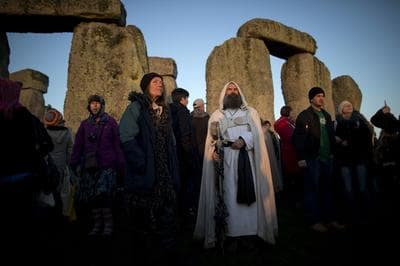Advertisement
Druids And Celts From A Real 'Middle Earth'
ResumeHobbitmania returns, and we look at the real legacy of druids and celts in the "Middle Earth" of Iron Age Western Europe.

"The Hobbit: The Desolation of Smau:g is number one at the movie box office right now. Fans pouring in to check out the latest drama from Tolkien’s Middle Earth – Bilbo and Gandalf, wizardry and runes. Historian Graham Robb goes back to the real Middle Earth in his latest work. To the historic heyday of druids and Celts before their rout by the Roman Empire. That Middle Earth, he says, was far more sophisticated and wide that we tend to know. A world that stretched right across Europe. Up next On Point: retracing the lost age of the druid’s real Middle Earth.
- Tom Ashbrook
Guest
Graham Robb, British author and historian. Author of the "The Discovery Of Middle Earth: Mapping the Lost World of the Celts." Also author of "The Discovery of France," "Parisians: An Adventure History Of Paris," "Strangers: Homosexual Love in the Nineteenth Century" and several biographies.
From Tom's Reading List
The Prospect: What did the Druids ever do for us? An interview with Graham Robb — "We tend to think of the efficient transmission of information as a feature of our own society. But one of the things that seems to have amazed the Romans is the way that the different [Celtic] tribes could form alliances at very short notice over huge distances."
The Christian-Science Monitor: The Discovery Of Middle Earth — "At the heart of 'The Discovery of Middle Earth' is a profound meditation on the nature of knowledge itself: not just its discovery or intrinsic value, but also (and perhaps centrally) how susceptible it is to being lost or corrupted. The Via Heraklea may be the example that Robb picks apart in detail, but other examples dance like flames throughout the pages of the book: the Antikythera Mechanism, a gear-driven mechanical 'hand-held computer' from the 2nd Century BC that acted as a complex calendar and navigation aid; the immense loss of ancient Druidic scholarship, which lived and eventually died through oral memory; and the burning of the Library of Alexandria, one of the great tragedies of the ancient world."
Los Angeles Times: Graham Robb's 'Discovery of Middle Earth' offers a new look at Celts — "Indeed, although the Druids were the learned elite of the ancient Celts, they are better known today as the inspiration for such flaky goings on as the gathering at Stonehenge of ersatz Druids in white robes celebrating the summer solstice. (Stonehenge actually antedates the Druids by millenniums.) They seem an odd subject for the critically praised biographer of Balzac, Hugo and Rimbaud, a historian whose previous works seldom look back further than the French Revolution."
Read An Excerpt Of "The Discovery Of Middle Earth" By Graham Robb
This program aired on December 23, 2013.